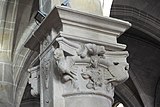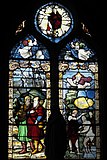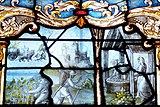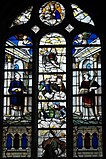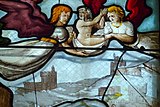St-Germain-de-Paris (Andrésy)
The Catholic parish church of St-Germain-de-Paris in Andrésy , a parish in the Yvelines department in the French region of Île-de-France , was built in the second half of the 12th and the beginning of the 13th centuries in Gothic style. The church is dedicated to St. Germanus of Paris and belongs to the diocese of Versailles . In 1949, the church, in which stained glass windows from the 16th century have been preserved, was added to the list of architectural monuments in France as Monument historique .
history
The oldest parts of the church are the four western bays of the main nave and the south aisle, which are believed to date from the second half of the 12th century. The choir was built in the first quarter of the 13th century. The vestibule on the west facade is dated to the 14th century. In the early 16th century, the choir was enlarged by adding side chapels to the four eastern bays of the south aisle, level with the choir. In 1538 the north aisle was replaced by a much wider one. In the course of this construction work, the church was equipped with lead glass windows. After a vault collapsed, the vaults of the north aisle were renewed at the end of the 19th century.
architecture
Exterior construction
The main nave opens to the west, on Rue de l'Église, to a pointed arched portal framed by archivolts , which is integrated into a vestibule in the Flamboyant Gothic style. The archivolts rest on slender columns adorned with leaf capitals that stand on high plinths. The slate-roofed tower rises above the western yoke of the nave , which is framed by corner pilasters and in the walls of which ogive blinding fields and coupled sound arcades are cut into the bell storey. The choir head facing the bank of the Seine on the east side is broken in the middle by a large, two-lane lancet window with oculus and at the side by two tracery windows. The portal on the east facade of the north aisle is covered by a basket arch and crowned by a triangular gable with an empty figure niche.
inner space
The nave , divided into five bays, consists of a main nave and two side aisles. The north aisle, which was built in the mid-16th century, is wider than the main aisle and twice as wide as the south aisle. In the east, the three-bay choir adjoins without an intervening transept . The two side aisles extend into the choir , with which they form a straight end. The four eastern bays of the south aisle open to side chapels.
The high, pointed arcades of the central nave rest on mighty pillars decorated with capitals , above which a triforium consisting of four high arcades runs in the four western bays on the south side under the windows of the upper aisle . In the choir, the triforias consist of five or six arcades. There is no triforium on the high walls facing the north aisle. The entire interior is covered by ribbed vaults with keystones .
Eleven capitals are dated to the second half of the 16th century. They are decorated with naked male figures with beards and female busts, some of which are winged. On some capitals eagles, sirens and heads framed by foliage are depicted. Fire salamanders , the heraldic animal of the French King Francis I, can be seen on two capitals .
Leaded glass window
16th century window
In the church there are five stained glass windows with panes from the 16th century.
- Window 2
The Emmaus disciples can be seen on the left of the window and the baptism of Jesus on the right , angels hover above them. Behind the Emmaus disciples, scenes from a grape harvest can be seen. A Majestas Domini is depicted in the upper disk between the two lancets .
- Window 5
In the middle of the three-lane window are Saint Benedict , the Apostle Peter and John the Baptist . In the tracery is the Sorrowful Christ to see.
- Window 9
See also: Root Jesse Window
Two deacons are depicted on the two outer lancets. The panes in the middle are fragments of a root Jesse window. The upper round window shows a Madonna and Child.
- Window 10
The birth of John the Baptist can be seen on the left of the two lancets and the circumcision of Jesus on the right . The scenes are embedded in Renaissance architecture, with an angel floating above.
- Window 11
The window contains scenes from the parable of the rich man and poor Lazarus . In the lower scene you can see a man dressed in fur and a richly embroidered robe, to whom food is served, dogs crouching at his feet. Precious vases and dishes can be seen in the background. In the next scene the table is set in the rich man's house and in the following scene you see poor Lazarus lying on the floor sharing the remains that fall from the rich man's table with the dogs. In the lower left scene the rich man is depicted in hellfire and in the lower right scene the soul of poor Lazarus is taken in by angels. The tympanum shows God the Father in the middle and angels to the side.
19th and 20th century windows
A Madonna and Child and Saint Joseph are depicted on a stained glass window from the 19th century . In another window you can see a bishop, perhaps the patron saint of the church, St. Germanus of Paris, and the apostle Paul . Another window shows a crucifixion scene with a priest at the feet of the cross and the apostle Peter in the tympanum. The window depicting the apparition of Mary in Pontmain is signed by the brothers Auguste and Ludovic Alleaume and the year 1930. The window, which contains medallions imitated in the Gothic style with scenes of torture, was created in 1958 by André Ripeau. Between 1968 and 1986 Michel Gigon designed four abstract windows that were made in the Cot-Dezande glass painting workshop.
Furnishing
- The wooden crucifix is dated to the 16th century.
- The painting depicting the Adoration of the Shepherds is attributed to the painter Lubin Baugin , who probably painted it after 1640, after his return from Italy.
- The painting on the subject of the raising of the young man from Naim dates from the 17th or early 18th century .
literature
- Louis Grodecki, Françoise Perrot, Jean Taralon (eds.): Les vitraux de Paris, de la région parisienne, de la Picardie et du Nord-Pas-de-Calais . (= Corpus Vitrearum Medii Aevi ). Récensement des vitraux anciens de la France. Volume 1, Éditions du Center National de la Recherche Scientifique, Paris 1978, ISBN 2-222-02263-0 , pp. 126–127.
- Jean-Marie Pérouse de Montclos (ed.): Le Guide du Patrimoine. Île-de-France . Hachette, 2nd edition, Paris 1994, ISBN 2-01-016811-9 , pp. 108-109.
- Georges Poisson (ed.): Dictionnaire des Monuments d'Île-de-France . Éditions Hervas, Paris 2001, ISBN 2-84334-002-0 , p. 67
Web links
- Église Saint-Germain-de-Paris Observatoire du Patrimoine Religieux
Individual evidence
- ↑ Renaissance window in Base Palissy of the French Ministry of Culture (French)
- ^ Église Saint-Germain in the Base Mérimée of the French Ministry of Culture (French)
- ↑ Église paroissiale Saint-Germain in the Base Mérimée of the French Ministry of Culture (French)
- ↑ Eleven capitals in the Base Palissy of the French Ministry of Culture (French)
- ↑ The numbering of the windows, which differs from the Base Palissy, is based on the scheme by Louis Grodecki, Françoise Perrot, Jean Taralon (ed.): Les vitraux de Paris, de la région parisienne, de la Picardie et du Nord-Pas-de- Calais . (= Corpus Vitrearum Medii Aevi ). Récensement des vitraux anciens de la France. Volume 1, Éditions du Center National de la Recherche Scientifique, Paris 1978, ISBN 2-222-02263-0 , pp. 126–127.
- ^ Emmaus disciples, Baptism of Jesus in the Base Palissy of the French Ministry of Culture (French)
- ↑ Saint Benedict, Apostle Peter, John the Baptist in the Base Palissy of the French Ministry of Culture (French)
- ↑ Root Jesse in the Base Palissy of the French Ministry of Culture (French)
- ↑ Birth of John the Baptist, circumcision of Jesus in Base Palissy of the French Ministry of Culture (French)
- ↑ Rich man and poor Lazarus in Base Palissy of the French Ministry of Culture (French)
- ↑ Window from the 19th century in the Base Palissy of the French Ministry of Culture (French)
- ↑ apparition of Pontmain in the Base Palissy of the French Ministry of Culture (French)
- ↑ Torture scenes in the Base Palissy of the French Ministry of Culture (French)
- ↑ Abstract windows in the Base Palissy of the French Ministry of Culture (French)
- ↑ Crucifix in the Base Palissy of the French Ministry of Culture (French)
- ↑ Adoration of the Shepherds in Base Palissy of the French Ministry of Culture (French)
- ↑ Adoration of the Shepherds in Base Palissy of the French Ministry of Culture (French)
- ^ Resurrection of the youth of Naim in the base Palissy of the French Ministry of Culture (French)
- ^ Resurrection of the youth of Naim in the base Palissy of the French Ministry of Culture (French)
Coordinates: 48 ° 58 '36.8 " N , 2 ° 3' 33.1" E






